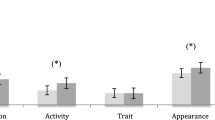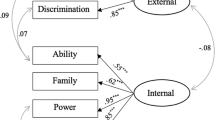Abstract
People often expect men and women to look, act, and think like typical members of their gender groups. When men and women deviate from gender-stereotypical expectations across various domains, people tend to denigrate them, compared to those who follow stereotypical expectations. This derogatory attitude—termed the backlash effect—has been well supported by psychological research. However, previous studies on the backlash effect have often neglected the fact that men and women can be counter-stereotypical of their gender groups, to varying degrees. This research tried to address this continuous nature of counter-stereotypical characteristics in various domains using six experiments to evaluate individual responses to gendered facial cues, behaviors, and psychological traits. We conducted three studies, with two experiments per study. Most importantly, this research proposed a threshold model of gender stereotype maintenance to explain people’s evaluations of gender-counter-stereotypical targets across various domains. The threshold model suggested that appraisal for a target with balanced gender-stereotypical and gender-counter-stereotypical characteristics tends to be more positive than for a target who strictly adheres to gender stereotypes or gender-counter-stereotypical characteristics. The results of all three studies supported the threshold model, which demonstrated a curvilinear pattern of participants’ appraisals and targets’ gender-counter-stereotypical degrees. The threshold model of stereotype maintenance has enriched the traditional stereotype maintenance theory and enlightened the development of a more effective impression management strategy. Moreover, it provided more ecological validity that treated gender counter-stereotype as a continuum rather than a binary variable.







Similar content being viewed by others
References
Albright, J. J., & Marinova, D. M. (2015). Estimating multilevel models using SPSS, Stata, SAS, and R. Retrieved from https://scholarworks.iu.edu/dspace/handle/2022/19737.
Bem, S. L. (1974). The measurement of psychological androgyny. Journal of Consulting and Clinical Psychology, 42(2), 155–162. https://doi.org/10.1037/h0036215.
Bem, S. L., & Lewis, S. A. (1975). Sex role adaptability: One consequence of psychological androgyny. Journal of Personality and Social Psychology, 31(4), 634. https://doi.org/10.1037/h0077098.
Bongiorno, R., Bain, P. G., & David, B. (2014). If you’re going to be a leader, at least act like it! Prejudice towards women who are tentative in leader roles. British Journal of Social Psychology, 53(2), 217–234. https://doi.org/10.1111/bjso.12032.
Brescoll, V. L., Dawson, E., & Uhlmann, E. L. (2010). Hard won and easily lost: The fragile status of leaders in gender-stereotype-incongruent occupations. Psychological Science, 21(11), 1640–1642. https://doi.org/10.1177/0956797610384744.
Brescoll, V. L., & Uhlmann, E. L. (2005). Attitudes toward traditional and nontraditional parents. Psychology of Women Quarterly, 29(4), 436–445. https://doi.org/10.1111/j.1471-6402.2005.00244.x.
Coyle, E. F., Fulcher, M., & Trübutschek, D. (2016). Sissies, mama’s boys, and tomboys: Is children’s gender nonconformity more acceptable when nonconforming traits are positive? Archives of Sexual Behavior, 45(7), 1827–1838. https://doi.org/10.1007/s10508-016-0695-5.
Cuddy, A. J., Fiske, S. T., & Glick, P. (2008). Warmth and competence as universal dimensions of social perception: The stereotype content model and the BIAS map. Advances in Experimental Social Psychology, 40, 61–149. https://doi.org/10.1016/s0065-2601(07)00002-0.
Deaux, K., & Lewis, L. L. (1984). Structure of gender stereotypes: Interrelationships among components and gender label. Journal of Personality and Social Psychology, 46(5), 991–1004. https://doi.org/10.1037/0022-3514.46.5.991.
DeBruine, L. M., Jones, B. C., Little, A. C., Boothroyd, L. G., Perrett, D. I., Penton-Voak, I. S., & Tiddeman, B. P. (2006). Correlated preferences for facial masculinity and ideal or actual partner’s masculinity. Proceedings of the Royal Society B: Biological Sciences, 273(1592), 1355–1360. https://doi.org/10.1098/rspb.2005.3445.
Diekman, A. B., Goodfriend, W., & Goodwin, S. (2004). Dynamic stereotypes of power: Perceived change and stability in gender hierarchies. Sex Roles, 50(3–4), 201–215. https://doi.org/10.1023/b:sers.0000015552.22775.44.
Durham, W. H. (1991). Coevolution: Genes, culture, and human diversity. Stanford, CA: Stanford University Press.
Eagly, A. H., & Karau, S. J. (2002). Role congruity theory of prejudice toward female leaders. Psychological Review, 109(3), 573–598. https://doi.org/10.1037//0033-295x.109.3.573.
Fiske, S. T., & Stevens, L. E. (1993). What’s so special about sex? Gender stereotyping and discrimination. In S. Oskamp & M. Costanzo (Eds.), Gender issues in contemporary society: Applied social psychology annual (pp. 173–196). Newbury Park, CA: Sage.
Freeman, J. B., Johnson, K. L., Ambady, N., & Rule, N. O. (2010). Sexual orientation perception involves gendered facial cues. Personality and Social Psychology Bulletin, 36(10), 1318–1331. https://doi.org/10.1177/0146167210378755.
Gutierrez, B. C., Halim, M. L. D., Ng, F. F. Y., Kwak, K., Ortiz-Cubias, S., Cheng, G. Y. L., & Sze, I. N. L. (2019). Gendered appearances among young children and in the media: An East-West cultural comparison. Sex Roles. https://doi.org/10.1007/s11199-019-01059-3.
Heilman, M. E., & Okimoto, T. G. (2007). Why are women penalized for success at male tasks? The implied communality deficit. Journal of Applied Psychology, 92(1), 81–92. https://doi.org/10.1037/0021-9010.92.1.81.
Heilman, M. E., & Wallen, A. S. (2010). Wimpy and undeserving of respect: Penalties for men’s gender-inconsistent success. Journal of Experimental Social Psychology, 46(4), 664–667. https://doi.org/10.1016/j.jesp.2010.01.008.
Heilman, M. E., Wallen, A. S., Fuchs, D., & Tamkins, M. M. (2004). Penalties for success: Reactions to women who succeed at male gender-typed tasks. Journal of Applied Psychology, 89(3), 416–427. https://doi.org/10.1037/0021-9010.89.3.416.
Heine, S. J. (2010). Cultural psychology. In S. T. Fiske, D. T. Gilbert, & G. Lindzey (Eds.), Handbook of social psychology (pp. 1423–1464). Hoboken, NJ: Wiley.
Henrich, J., Heine, S. J., & Norenzayan, A. (2010). The weirdest people in the world? Behavioral and Brain Sciences, 33(2–3), 61–83. https://doi.org/10.1017/s0140525x0999152x.
Herrero, J., Rodríguez, F. J., & Torres, A. (2017). Acceptability of partner violence in 51 societies: The role of sexism and attitudes toward violence in social relationships. Violence Against Women, 23(3), 351–367. https://doi.org/10.1177/1077801216642870.
Jackson, L. A. (1983). Gender, physical attractiveness, and sex role in occupational treatment discrimination: The influence of trait and role assumptions. Journal of Applied Social Psychology, 13(5), 443–458. https://doi.org/10.1111/j.1559-1816.1983.tb01751.x.
Maas, C. J. M., & Hox, J. J. (2005). Sufficient sample sizes for multilevel modeling. Methodology, 1(3), 86–92.
Marhenke, T., & Imhoff, R. (2019). Does Bem’s psychological androgyny map on gender or sex differences in faces? Psychology, Society, & Education, 11(1), 99–112. https://doi.org/10.25115/psye.v11i1.2071.
Markus, H. R., & Kitayama, S. (1991). Culture and the self: Implications for cognition, emotion, and motivation. Psychological Review, 98(2), 224–253. https://doi.org/10.1037/0033-295x.98.2.224.
Martin, C. L., Cook, R. E., & Andrews, N. C. (2017). Reviving androgyny: A modern day perspective on flexibility of gender identity and behavior. Sex Roles, 76(9–10), 592–603. https://doi.org/10.1007/s11199-016-0602-5.
Moss-Racusin, C. A. (2014). Male backlash: Penalties for men who violate gender stereotypes. In R. J. Burke & D. A. Major (Eds.), Gender in organizations: Are men allies or adversaries to women’s career advancement (pp. 247–269). Cheltenham, England: Edward Elgar Publishing.
Moss-Racusin, C. A., Phelan, J. E., & Rudman, L. A. (2010). When men break the gender rules: Status incongruity and backlash against modest men. Psychology of Men & Masculinity, 11(2), 140–151. https://doi.org/10.1037/a0018093.
Mroczek, D. K., & Spiro, A. (2005). Change in life satisfaction during adulthood: Findings from the veterans affairs normative aging study. Journal of Personality and Social Psychology, 88, 189–202. https://doi.org/10.1037/0022-3514.88.1.189.
Paulhus, D. L., & Martin, C. L. (1987). The structure of personality capabilities. Journal of Personality and Social Psychology, 52(2), 354–365. https://doi.org/10.1037/0022-3514.52.2.354.
Rhodes, G., Hickford, C., & Jeffery, L. (2000). Sex-typicality and attractiveness: Are supermale and superfemale faces super-attractive? British Journal of Psychology, 91(1), 125–140. https://doi.org/10.1348/000712600161718.
Rogosa, D., Brandt, D., & Zimowski, M. (1982). A growth curve approach to the measurement of change. Psychological Bulletin, 92(3), 726–748. https://doi.org/10.1037/0033-2909.92.3.726.
Rudman, L. A. (1998). Self-promotion as a risk factor for women: The costs and benefits of counterstereotypical impression management. Journal of Personality and Social Psychology, 74, 629–645. https://doi.org/10.1037//0022-3514.74.3.629.
Rudman, L. A., & Fairchild, K. (2004). Reactions to counterstereotypic behavior: The role of backlash in cultural stereotype maintenance. Journal of Personality and Social Psychology, 87(2), 157–176. https://doi.org/10.1037/0022-3514.87.2.157.
Rudman, L. A., & Glick, P. (1999). Feminized management and backlash toward agentic women: The hidden costs to women of a kinder, gentler image of middle managers. Journal of Personality and Social Psychology, 77, 1004–1010. https://doi.org/10.1037//0022-3514.77.5.1004.
Rudman, L. A., & Glick, P. (2001). Prescriptive gender stereotypes and backlash toward agentic women. Journal of Social Issues, 57(4), 743–762. https://doi.org/10.1111/0022-4537.00239.
Rudman, L. A., & Mescher, K. (2013). Penalizing men who request a family leave: Is flexibility stigma a femininity stigma? Journal of Social Issues, 69(2), 322–340. https://doi.org/10.1111/josi.12017.
Rudman, L. A., Moss-Racusin, C. A., Glick, P., & Phelan, J. E. (2012a). Reactions to vanguards: Advances in backlash theory. Advances in Experimental Social Psychology, 45, 167–227.
Rudman, L. A., Moss-Racusin, C. A., Phelan, J. E., & Nauts, S. (2012b). Status incongruity and backlash effects: Defending the gender hierarchy motivates prejudice against female leaders. Journal of Experimental Social Psychology, 48(1), 165–179. https://doi.org/10.1016/j.jesp.2011.10.008.
Rudman, L. A., & Phelan, J. E. (2008). Backlash effects for counter stereotypical behavior in organizations. In A. Brief & B. M. Staw (Eds.), Research in organizational behavior (Vol. 28, pp. 61–79). New York: Elsevier.
Spence, J. T. (1993). Gender-related traits and gender ideology: Evidence for a multifactorial theory. Journal of Personality and Social Psychology, 64(4), 624–635. https://doi.org/10.1037/0022-3514.64.4.624.
Spence, J. T., & Buckner, C. E. (2000). Instrumental and expressive traits, trait stereotypes and sexist attitudes: What do they signify? Psychology of Women Quarterly, 24(1), 44–62. https://doi.org/10.1111/j.1471-6402.2000.tb01021.x.
Spence, J. T., & Helmreich, R. L. (1979a). Comparison of masculine and feminine personality attributes and sex-role attitudes across age groups. Developmental Psychology, 15, 583–584. https://doi.org/10.1037/h0078091.
Spence, J. T., & Helmreich, R. L. (1979b). On assessing “androgyny”. Sex Roles, 5, 721–738. https://doi.org/10.1007/BF00287935.
Taylor, M. C., & Hall, J. A. (1982). Psychological androgyny: Theories, methods, and conclusions. Psychological Bulletin, 92(2), 347–366. https://doi.org/10.1037/0033-2909.92.2.347.
Thelen, E., & Smith, L. B. (2007). Dynamic systems theories. In W. Damon & R. M. Lerner (Eds.), Handbook of child psychology: Theoretical models of human development (6th ed., pp. 258–312). Hoboken, NJ: Wiley. https://doi.org/10.1002/9780470147658.chpsy0106.
van Anders, S. M., Steiger, J., & Goldey, K. L. (2015). Effects of gendered behavior on testosterone in women and men. Proceedings of the National Academy of Sciences, 112(45), 13805–13810. https://doi.org/10.1073/pnas.1509591112.
Vandello, J. A., & Bosson, J. K. (2013). Hard won and easily lost: A review and synthesis of theory and research on precarious manhood. Psychology of Men & Masculinity, 14(2), 101–113. https://doi.org/10.1037/a0029826.
Vandello, J. A., Bosson, J. K., Cohen, D., Burnaford, R. M., & Weaver, J. R. (2008). Precarious manhood. Journal of Personality and Social Psychology, 95(6), 1325. https://doi.org/10.1037/a0012453.
Wen, F., Zuo, B., Wu, Y., Sun, S., & Liu, K. (2014). Red is romantic, but only for feminine females: Sexual dimorphism moderates red effect on sexual attraction. Evolutionary Psychology, 12(4), 719–735. https://doi.org/10.1177/147470491401200404.
Wiggins, J. S., & Holzmuller, A. (1981). Further evidence on androgyny and interpersonal flexibility. Journal of Research in Personality, 15(1), 67–80. https://doi.org/10.1016/0092-6566(81)90008-8.
Zucker, K. J., Wilson-Smith, D. N., Kurita, J. A., & Stern, A. (1995). Children’s appraisals of sex-typed behavior in their peers. Sex Roles, 33(11–12), 703–725. https://doi.org/10.1007/BF01544775.
Zuo, B., & Liu, X. (2006). The researches of implicit gender stereotype based on IAT and SEB. Psychological Development and Educaiton, 22(4), 57–63.
Zuo, B., Wen, F., & Wu, Y. (2019). Sex differences in mate retention and mate quality enhancement: The effect of facial sexual dimorphism cues on willingness to introduce a new friend to one’s partner. Archives of Sexual Behavior, 48(6), 1785–1794. https://doi.org/10.1007/s10508-018-1295-3.
Acknowledgements
We would like to thank our colleagues and students at CSSP of CCNU and Mr. Christopher D. Petsko at the Department of Psychology of Northwestern University, for their kind support.
Funding
The funding was provided by the National Natural Science Foundation of China (Grand Nos. 31571147, 31400903) and the Major Program of National Social Science Foundation of China (Grand No. 18ZDA331).
Author information
Authors and Affiliations
Corresponding author
Ethics declarations
Conflict of interest
The authors declare that they have no conflict of interest.
Ethical Approval
All experiments were carried out in accordance with the recommendations of the School of Psychology Ethics Committee of Central China Normal University.
Informed Consent
All participants read informed consent carefully at the very beginning of every experiment and voluntarily completed the following part. Participants received course credits or CNY ¥5 as compensation for their time.
Additional information
Publisher's Note
Springer Nature remains neutral with regard to jurisdictional claims in published maps and institutional affiliations.
Rights and permissions
About this article
Cite this article
Wen, F., Zuo, B., Wang, Y. et al. The (Continuous) Nature of Perceived Gender Counter-Stereotype: A Threshold Model of Gender Stereotype Maintenance. Arch Sex Behav 49, 2511–2530 (2020). https://doi.org/10.1007/s10508-020-01763-2
Received:
Revised:
Accepted:
Published:
Issue Date:
DOI: https://doi.org/10.1007/s10508-020-01763-2




